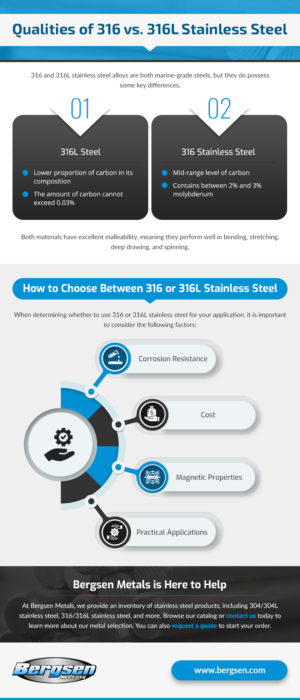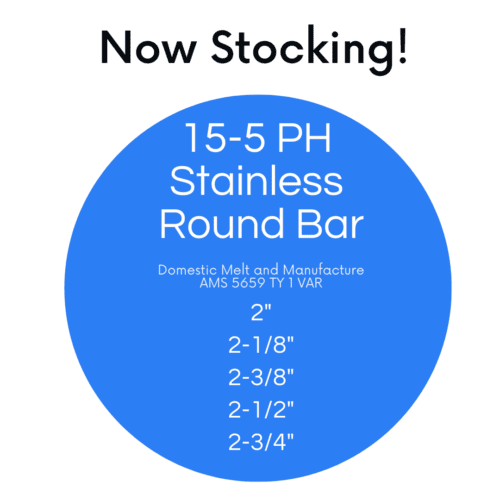316 vs 316L Stainless Steel: What’s the Difference?
Stainless steel is a broad category of steel alloys that have some proportion of chromium that protects the metal from corrosion and related damage. The amount of chromium in the alloy — as well as the amounts of other metallic elements — differs depending on which variation of stainless steel you’re working with.
316 stainless steel is a popular alloy that possesses molybdenum. Unlike 304 steel, the most common form of stainless steel, it possesses enhanced resistance to corrosion from chloride and other acids. This makes it ideal for outdoor applications in marine environments or applications that risk potential exposure to chloride.
316 steel comes in different varieties, including 316L. 316L stainless steel possesses less carbon and molybdenum than typical 316 steel, which gives the two alloys different characteristics. This article will explore the fundamental differences between the alloys so you can choose the best fit for your application.
Definition of Stainless Steel
Like steel, stainless steel is primarily composed of iron and carbon. However, stainless steel is also composed of at least 10.5% chromium, a metallic element that gives the metal its finish and superior corrosion resistance. Stainless steel is ideal for long-term applications that will face the elements, moisture, and potentially corrosive chemicals. It’s also ideal for sensitive industries such as food preparation and pharmaceuticals, as the risk of contamination is much lower.
Different grades of stainless steel also contain traces of different elements. Grade 304 stainless steel contains up to 35% nickel and is used for applications such as appliances, cookware, tubing, and hardware. Grade 316 contains molybdenum, making it ideal for marine equipment, chemical and pharmaceutical manufacturing equipment, and commercial kitchen equipment.
Qualities of 316 vs. 316L Stainless Steel
316 and 316L stainless steel alloys are both marine-grade steels, but they do possess some key differences. 316L has a lower proportion of carbon in its composition. To qualify as 316L stainless steel, the amount of carbon cannot exceed 0.03%. This decreases the risk of carbon precipitation, making it a better option for welding to ensure maximum corrosion resistance.
316 stainless steel has a mid-range level of carbon and contains between 2% and 3% molybdenum, which increases resistance to corrosion, acidic elements, and high temperatures. Both materials have excellent malleability, meaning they perform well in bending, stretching, deep drawing, and spinning.
How to Choose Between 316 or 316L Stainless Steel
When determining whether to use 316 or 316L stainless steel for your application, it is important to consider the following factors:
Corrosion Resistance
316L is the superior choice for high corrosion and high temperature applications. Since 316L contains less carbon than 316, it has better intergranular corrosion resistance, meaning its welds won’t decay, unlike with 316 stainless steel.
Cost
Although 316L contains less carbon, 316 and 316L stainless steels cost approximately the same.
Magnetic Properties
316 stainless steel has very low responsiveness to magnetic fields. Unlike basic stainless steels, which are ferromagnetic, most stainless steel varieties (including 316) are austenitic — or effectively nonmagnetic.
However, some 316 stainless steel goods can undergo processes, like cold forming and welding, where the austenitic crystal structure is transformed into ferromagnetic martensite. 316L steel is more susceptible to gaining some degree of magnetism.
Practical Applications
Both types of stainless steel are useful in a wide variety of industries. However, 316 is primarily used in construction and infrastructure because it is strong, resistant to pitting, and corrosion resistant in most circumstances. 316L is popular for pharmaceutical and photography equipment because it can withstand welding and corrosive chemicals.
Bergsen Metals is Here to Help
The key difference between 316 and 316L stainless steel is the carbon content. While 316 has a maximum carbon content of 0.08%, 316L has a maximum carbon content of only 0.03%.
At Bergsen Metals, we provide an inventory of stainless steel products, including 304/304L stainless steel, 316/316L stainless steel, and more. Browse our catalog or contact us today to learn more about our metal selection. You can also request a quote to start your order.






